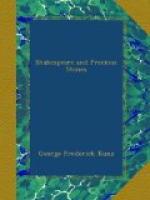It will have been seen that the text of Shakespeare’s plays gives no evidence tending to show any greater familiarity with precious stones than could be gathered from the poetry of his day, and from his intercourse with classical scholars, such as Francis Bacon, Ben Jonson, and others of those who formed the unique assemblage wont to meet together at the old Mermaid Tavern in London. That a diamond could cost 2000 ducats ($5000), a very large sum in Shakespeare’s time, is noted in one of his earliest plays, the Merchant of Venice (Act iii, sc. 1), and the following injunction emphasizes the great value of a fine diamond:
Set this diamond
safe
In golden palaces,
as it becomes.
I
Henry VI, Act v, sc. 3.
“Histories”,
p. 116, col. B, line 54.
In Pericles we read (Act iii, sc. 2):
The diamonds of a most praised
water
Do appear, to make the world twice rich.
Third Folio, 1664, p. 7, col.
B, line 38;
separate pagination.
In Shakespeare’s time but few of the world’s great diamonds were in Europe, though two, at least, were in his native country. All of them must have been of East Indian origin, as this was before the discovery of the Brazilian mines (1728). In 1547, Henry VIII of England bought of the Fuggers of Augsburg—the great money-lending bankers and jewel setters, or royal pawnbrokers, who generally sold or forced some jewels upon those who obtained a loan—the jewel of Charles the Bold, called the “Three Brethren”, from three large balas-rubies with which it was set; the central ornament was a “great pointed diamond”; of its weight nothing is known. This jewel was lost by Duke Charles on the field of Granson, March 2, 1476, where it was secured by the Swiss victors; it was eventually bought by the Fuggers. The other fine English diamond was that known as the Sancy, weighing 53-3/4 carats (55.23 metric carats), acquired by James I from Nicholas Harley de Sancy, in 1604, for 500,000 crowns. This is also stated to have belonged to Charles the Bold. In 1657 it was redeemed by Cardinal Mazarin, after having been pledged for a loan by Queen Henrietta Maria, and at Mazarin’s death, in 1661, was bequeathed, with his other diamonds, to the French Crown. After passing through many vicissitudes, it has recently come into the possession of Baron Astor of Hever (William Waldorf Astor).
There is a possibility that the Florentine diamond of 133-22/32 carats (137.27 metric carats) was already owned by the grand-ducal house of Tuscany before Shakespeare’s death, but the earliest notice of it appears to be that given by Fermental, a French traveller, who saw it in Florence in 1630. The other great diamonds of former days are of more recent date. The Regent of 136-7/8 carats (140.64 metric carats), found in India about 1700, was acquired by the Duke of Orleans in 1717; the Orloff (194-3/4 old carats = 199.73 metric




